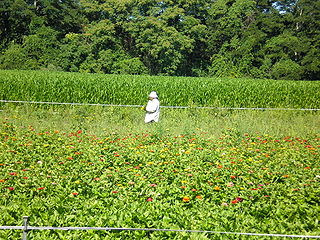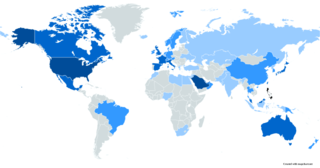A global care chain is a globalized labor market for workers who provide care-intensive labor, such as childcare, eldercare and healthcare. [1] The term was coined by the feminist sociologist Arlie Hochschild. [2] The movement of these workers is an important topic for research and policy development since the number of international migrants around the world has grown substantially since the 1990s. [2]
The concept of a global care chain is usually referenced in studies of development, including the United Nations Development Program, which explains that this type of labor is important for the economic development of a country. [1] Care-intensive labor often falls on women due to gender-stereotypes. Many examples exist of women in developing countries emigrating to more developed countries to help provide for their families back home by sending remittances. [1] Migrant workers may fill gaps in the labor market of developed countries, or may help fulfill domestic duties in dual-income households abroad. [2] This mass migration often has detrimental impacts on poorer countries, creating transnational families and loss of formal workers to care for elders, children and the sick within migrant countries. [1]
As Ehrenreich and Hochschild point out in their book, women workers emigrate for both economic and non-economic factors. [3] While some want to improve their living conditions, others might just want to leave an unhappy marriage or avoid the responsibilities of taking care of the elders at home. [3]
Italy has had a great influx of 30 to 45 year old Filipina migrants since 1970. [4] This is due to the demand for care workers within Italy since the country does not have a strong welfare and social service program set in place. Thus Filipinas often travel to Italy, the global north, in search of opportunities, but it is common for Filipina migrants to be able to only uphold temporary jobs that are poorly paid, since they are rarely offered permanent contracts. This causes Filipinas to be caught within the global care chain, in which they work low wage, care-intensive jobs so that they are able to send remittances back home. In 2008, the Philippines received $17 billion in the form of remittances, placing the country as the fourth highest remittance-receiving country. [4]
At the turn of this century, about 130,000 health professionals born in Africa were employed abroad. [2] A case study of African migrant women revealed that many physicians and nurses trained in African countries have been underutilized by countries they migrate to since their training and education is not considered legitimate. [2] To be qualified to perform their chosen health professions abroad, they usually need to repeat years’ worth of training as well as other exams and certifications. [2] This was true for people who had remained in the Global South or who had migrated to the Global North. [2] Many of these women had to leave the field of healthcare or accept positions with less responsibility than they had when they worked in their original countries of origin. [2] A large proportion of them experienced discrimination in their newly acquired positions as caregivers, whether they remained health workers or were forced to pursue other careers. [2]

Human migration is the movement of people from one place to another with intentions of settling, permanently or temporarily, at a new location. The movement often occurs over long distances and from one country to another, but internal migration is also possible; indeed, this is the dominant form of human migration globally. Migration is often associated with better human capital at both individual and household level, and with better access to migration networks, facilitating a possible second move. It has a high potential to improve human development, and some studies confirm that migration is the most direct route out of poverty.Age is also important for both work and non-work migration. People may migrate as individuals, in family units or in large groups. There are four major forms of migration: invasion, conquest, colonization and emigration/immigration.

Foreign workers or guest workers are people who work in a country other than one of which they are a citizen. Some foreign workers use a guest worker program in a country with more preferred job prospects than in their home country. Guest workers are often either sent or invited to work outside their home country or have acquired a job before leaving their home country, whereas migrant workers often leave their home country without a specific job in prospect.

Arlie Russell Hochschild is an American professor emeritus of sociology at the University of California, Berkeley and writer. Hochschild has long focused on the human emotions that underlie moral beliefs, practices, and social life generally. She is the author of nine books including, most recently Strangers in Their Own Land: Anger and Mourning on the American Right, a finalist for the National Book Award. In The Second Shift, The Managed Heart, The Time Bind, and many of her other books, she continues the tradition of C. Wright Mills by drawing links between private troubles and public issues. Hochschild had a personal fascination with the relationship between peoples inner experiences and outer appearance, so Mills’ concepts of private troubles and personal issues were very influential in the direction of her later works in studying emotion sociologically. His influence can be seen quite clearly in Strangers in Their Own Land: Anger and Mourning on the American Right where she analyzes the lives of immigrants for her emotion research.
An economic migrant is someone who emigrates from one region to another, including crossing international borders, seeking an improved standard of living, because the conditions or job opportunities in the migrant's own region are insufficient. The United Nations uses the term migrant worker.

A migrant worker is a person who migrates within a home country or outside it to pursue work. Migrant workers usually do not have the intention to stay permanently in the country or region in which they work.
Transnationalism is a research field and social phenomenon grown out of the heightened interconnectivity between people and the receding economic and social significance of boundaries among nation states.

An overseas Filipino is a person of full or partial Filipino origin—i.e., people who trace back their ancestry to the Philippines but living or residing outside the country. This term generally applies to both people of Filipino ancestry and citizens abroad. As of 2019, there were over 12 million Filipinos overseas.
The 'Economy of the Caribbean' is varied, but depends heavily on natural resources, agriculture and travel and tourism.

A remittance is a non-commercial transfer of money by a foreign worker, a member of a diaspora community, or a citizen with familial ties abroad, for household income in their home country or homeland. Money sent home by migrants competes with international aid as one of the largest financial inflows to developing countries. Workers' remittances are a significant part of international capital flows, especially with regard to labor-exporting countries.
Geographic mobility is the measure of how populations and goods move over time. Geographic mobility, population mobility, or more simply mobility is also a statistic that measures migration within a population. Commonly used in demography and human geography, it may also be used to describe the movement of animals between populations. These moves can be as large scale as international migrations or as small as regional commuting arrangements. Geographic mobility has a large impact on many sociological factors in a community and is a current topic of academic research. It varies between different regions depending on both formal policies and established social norms, and has different effects and responses in different societies. Population mobility has implications ranging from administrative changes in government and impacts on local economic growth to housing markets and demand for regional services.
Mixtec transnational migration is the phenomenon whereby Mixtec people have migrated between Mexico and the United States, for over three generations.

Overseas Filipino Worker (OFW) is a term often used to refer to Filipino migrant workers, people with Filipino citizenship who reside in another country for a limited period of employment. The number of these workers was roughly 1.77 million between April and September 2020. Of these, female workers comprised a larger portion, making up 59.6 percent, or 1.06 million. However, this number declined to 405.62 thousand between 2019 and 2020.
Migrant domestic workers are, according to the International Labour Organization’s Convention No. 189 and the International Organization for Migration, any persons "moving to another country or region to better their material or social conditions and improve the prospect for themselves or their family," engaged in a work relationship performing "in or for a household or households." Domestic work itself can cover a "wide range of tasks and services that vary from country to country and that can be different depending on the age, gender, ethnic background and migration status of the workers concerned." These particular workers have been identified by some academics as situated within "the rapid growth of paid domestic labor, the feminization of transnational migration, and the development of new public spheres." Prominent discussions on the topic include the status of these workers, reasons behind the pursue in this labour, recruitment and employment practices in the field, and various measures being undertaken to change the conditions of domestic work among migrants.

Circular migration or repeat migration is the temporary and usually repetitive movement of a migrant worker between home and host areas, typically for the purpose of employment. It represents an established pattern of population mobility, whether cross-country or rural-urban. There are several benefits associated with this migration pattern, including gains in financial capital, human capital, and social capital. There are also costs associated with circular migration, such as brain drain, poor working conditions, forced labor, and the inability to transfer acquired skills to home economies. Socially, there are strong connections to gender, health outcomes, development, poverty, and global immigration policy.
International migration occurs when people cross state boundaries and stay in the host state for some minimum length of the time. Migration occurs for many reasons. Many people leave their home countries in order to look for economic opportunities in another country. Others migrate to be with family members who have migrated or because of political conditions in their countries. Education is another reason for international migration, as students pursue their studies abroad, although this migration is often temporary, with a return to the home country after the studies are completed.
Remittances to Nepal are money transfers from Nepalese workers employed outside the country to friends or relatives in Nepal and forms part of the wider global remittance transfers by migrant workers back to their home countries.
Filipino domestic workers in Canada are Overseas Filipino Workers who frequently immigrated through the Live-In Caregiver program, which was cancelled to new applicants in 2014. After immigration processes and approval "the Live in Caregiver Program required of participants that they work as a live-in caregiver for two full years before applying for an open visa ". Many Filipinas found this program attractive because of their need to provide for their families, especially children. One of the main ways to provide for their children is giving them proper education. Highly valuing this, "a larger proportion of the mostly women who have come through these programs have come from the Philippines; by 1996 fully 87 percent came from the Philippines."
Women migrant workers from developing countries engage in paid employment in countries where they are not citizens. While women have traditionally been considered companions to their husbands in the migratory process, most adult migrant women today are employed in their own right. In 2017, of the 168 million migrant workers, over 68 million were women. The increase in proportion of women migrant workers since the early twentieth century is often referred to as the "feminization of migration".
Almost half of international migrants are women, generally travelling as either migrant workers or refugees. Women migrant workers migrate from developing countries to high-income countries to engage in paid employment, typically in gendered professions such as domestic work. Because their work disproportionately takes place in private homes, they are vulnerable to exploitation and abuse. Wages earned are largely sent home to the originating country to support the cost of living of the family left behind.
The term care drain coined in 2002 by the feminist sociologist Arlie Hochschild, is a feminist critique of brain drain's under theorization of the feminized migration in the global care chain and the impact it has on the families these women leave behind. Conversely care gain refers to the benefits for women migrant workers, their families and the sending nations.